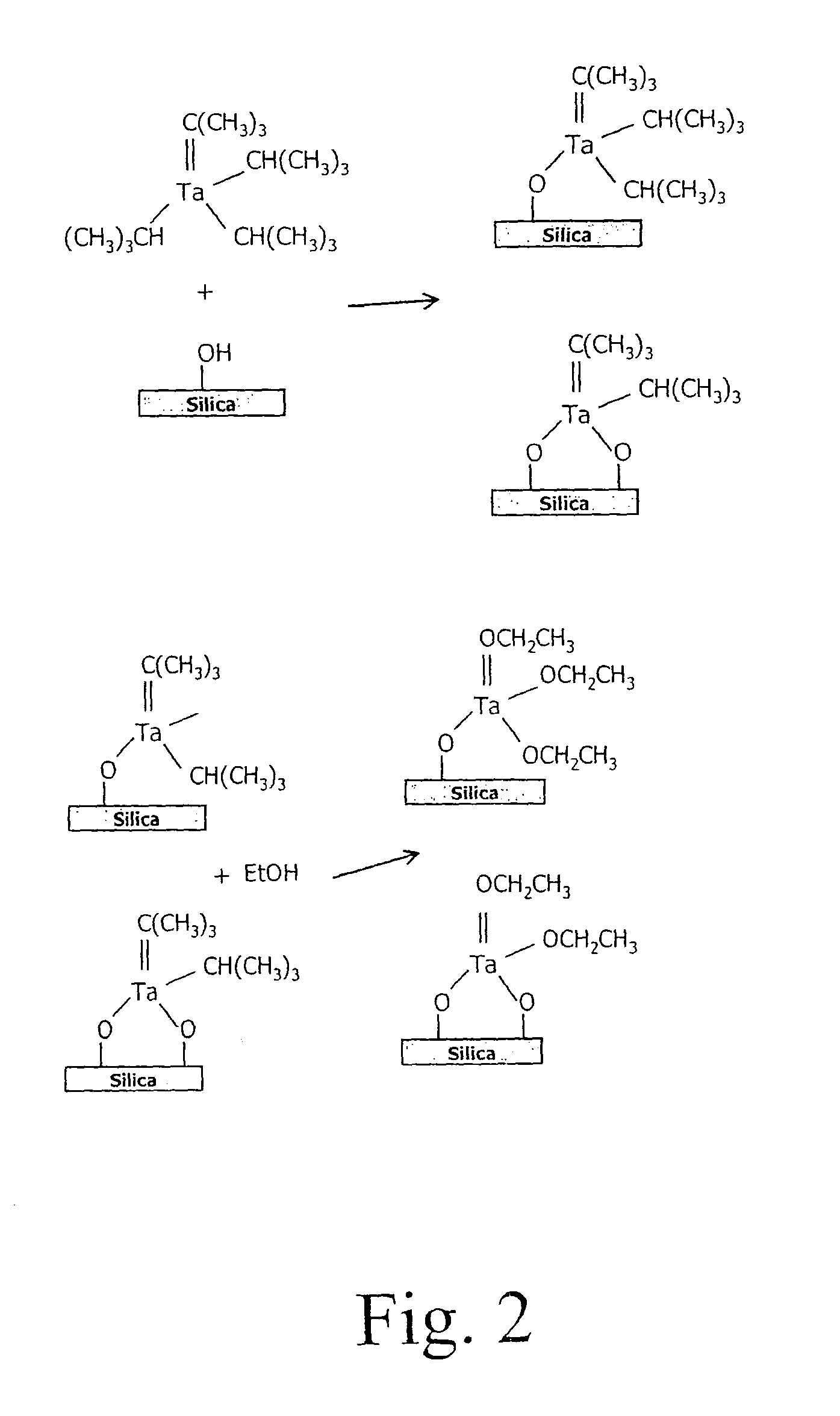Tethered catalyst processes in microchannel reactors and systems containing a tethered catalyst or tethered chiral auxiliary
a technology of tethered catalyst and microchannel reactor, which is applied in the direction of catalytic reactions, metal/metal-oxide/metal-hydroxide catalysts, chemical/physical processes, etc., can solve the problems of catalyst recovery, catalyst decomposition, and additional process steps and capital costs, so as to achieve superior selectivity and minimization of by-products, and superior heat and/or mass transfer characteristics
- Summary
- Abstract
- Description
- Claims
- Application Information
AI Technical Summary
Benefits of technology
Problems solved by technology
Method used
Image
Examples
example 1
The Knoevenagel Reaction
[0063]The Knoevenagel reaction1 is a base catalyzed condensation reaction, typically between aldehydes and activated methylene compounds, and is one of the most important C—C bond forming reactions available to synthetic chemists. Usually catalyzed by strong bases such as sodium and potassium hydroxides and organic bases such as piperidine and pyridine in homogeneous reactions, the reaction is promoted by removal of water that drives the reaction equilibrium to the right. The use of solid catalysts has provided a simplification to the separation and purification of these reactions and catalysts such as basic zeolites2 and amino-modified silicas3 have been used. A recent communication reported the use of a multi-channelled membrane microreactor using Cs-exchanged faujasite NaX as the catalyst.4
[0064]The Knoevenagel reaction exemplified here was the condensation of benzaldehyde and ethyl cyanoacetate which forms α-cyanocinnamic acid ethyl ester, an intermediat...
example 2
The Heck Reaction
[0082]The arylation and alkenylation of alkenes under the influence of a palladium catalyst has been extensively studied and applied to organic synthesis since the late 1960s5. The creation of new C—C bonds in the Heck Reaction is commonly catalysed homogeneously by palladium species generated from either Pd(0) compounds (e.g. [Pd(PPh3)4], [Pd2(dba)3]) or from Pd(II) salts (e.g. the acetate or chloride).
[0083]The model reaction system exemplified here is the coupling of iodobenzene with butyl acrylate to give butyl cinnamate.
[0084]
Preparation of Tethered Heck Catalysts.
[0085]The tethered catalysts used in these tests were based on a Schiff base palladium catalyst reported by Clark et al.6 The active catalysts were tethered to silica coatings on the aluminium walls of the microchannel reactor. The preparation of the catalyst initially involves the modification of the silica coated aluminium surface with aminopropyl moieties that are subsequently converted to the Schi...
example 3
The Michael Reaction
[0091]The Michael reaction is a conjugate addition reaction that involves the formation of new carbon-carbon bonds. Typically this reaction is base catalysed employing bases such as diisopropylamine, potassium t-butoxide and tetramethylguanidine7. Heterogeneous catalysis of Michael reactions has been accomplished using systems such as KF and CsF on alumina8, potassium t-butoxide on xonotlite9 and Amberlyst A-2710.
[0092]The model system exemplified here involves reaction between methyl vinyl ketone (but-3-en-one) and excess nitroethane.
[0093]
Preparation of the Tethered Catalyst for the Michael Reaction
[0094]The N,N-dimethylaminopropyl tethered catalyst shown below was prepared on the silica coated aluminium walls of the microchannel flowcell reactor.
[0095]
The modification of the reactor walls was a similar procedure to that used for the base catalyst (aminopropyl) used in the Knoevenagel reaction above, except that here N,N-dimethylpropylaminotrimethoxysilane was ...
PUM
| Property | Measurement | Unit |
|---|---|---|
| length | aaaaa | aaaaa |
| length | aaaaa | aaaaa |
| size | aaaaa | aaaaa |
Abstract
Description
Claims
Application Information
 Login to View More
Login to View More - R&D
- Intellectual Property
- Life Sciences
- Materials
- Tech Scout
- Unparalleled Data Quality
- Higher Quality Content
- 60% Fewer Hallucinations
Browse by: Latest US Patents, China's latest patents, Technical Efficacy Thesaurus, Application Domain, Technology Topic, Popular Technical Reports.
© 2025 PatSnap. All rights reserved.Legal|Privacy policy|Modern Slavery Act Transparency Statement|Sitemap|About US| Contact US: help@patsnap.com



